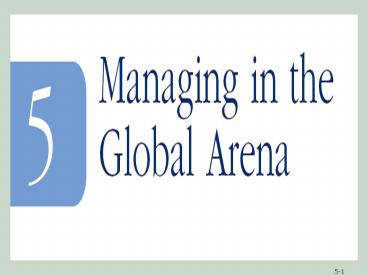Modern Management, 10e (Certo) - PowerPoint PPT Presentation
1 / 16
Title:
Modern Management, 10e (Certo)
Description:
1. An understanding of international management and its importance to modern managers 2. An understanding of what constitutes a multinational corporation 3. – PowerPoint PPT presentation
Number of Views:181
Avg rating:3.0/5.0
Title: Modern Management, 10e (Certo)
1
(No Transcript)
2
Objectives
- 1. An understanding of international management
and its importance to modern managers - 2. An understanding of what constitutes a
multinational corporation - 3. Insights concerning the risk involved in
investing in international operations - 4. Insights into those who work in multinational
corporations - 5. Knowledge about managing multinational
corporations - 6. Knowledge about managing multinational
organizations versus transnational organizations - 7. An understanding of how ethics and the
preparation of expatriates relate to managing
internationally
3
Managing Across the Globe Why?
- Great opportunities in the international
marketplace today - U.S. population growth slow but steady
- Other countries having population explosions
- Strong profit potential has serious risk
- Some challenges are
- Cultural differences
- Different technology levels
- Laws and political systems
4
Fundamentals of International Management
5
Categorizing Organizations by International
Involvement
6
Categorizing Organizations by International
Involvement
- Domestic Organizations
- International Organizations
- Multinational Organizations The Multinational
Corporation - Defining the Multinational Corporation
7
Categorizing Organizations by International
Involvement
8
Categorizing Organizations by International
Involvement
- Complexities of Managing the Multinational
Corporation - 1. Within different national sovereignties
- 2. Under widely disparate economic conditions
- 3. Among people living within different value
systems and institutions - 4. In places experiencing the industrial
revolution at different times - 5. Often over greater geographical distance
- 6. In national markets varying greatly in
population and area
9
Categorizing Organizations by International
Involvement
10
Categorizing Organizations by International
Involvement
- Risk and the Multinational Corporation
- 1. Reduce or eliminate high transportation costs
- 2. Allow participation in the rapid expansion of
a market abroad - 3. Provide foreign technical, design, and
marketing skills - 4. Earn higher profits
- The Workforce of Multinational Corporations
- Types of Organization Members Found in
Multinational Corporations - Expatriates
- Host-Country Nationals
- Third-Country Nationals
- Workforce Adjustments
- Adjusting to a New Culture
- Repatriation
11
Management Functions and Multinational
Corporations
- Planning in Multinational Corporations
- Plans for multinational organizations could
include - 1. Establishing a new sales force in a foreign
country - 2. Developing new manufacturing plants in other
countries - 3. Financing international expansion
- 4. Determining which countries are most suitable
- Components of International Plans
- Imports/Exports
- License Agreements
- Direct Investing
- Joint Ventures
- Planning and International Market Agreements
- The European Union (EU)
- North American Free Trade Agreement (NAFTA)
- Asian-Pacific Economic Cooperation (APEC)
12
Management Functions and Multinational
Corporations
13
Management Functions and Multinational
Corporations
14
Management Functions and Multinational
Corporations
- Organizing Multinational Corporations
- Organization Structure
- Selection of Managers
- Managerial Attitudes Toward Foreign Operations
- Advantages and Disadvantages of Each Management
Attitude - Influencing People in Multinational Corporations
- Culture
- 1. Acquire a working knowledge of the languages
- 2. Understand the attitudes of people
- 3. Understand the needs that motivate people
- Controlling Multinational Corporations
- Special Difficulties
- Improving Communication
- Transnational Organizations
15
Management Functions and Multinational
Corporations
16
International Management Special Issues
- Maintaining Ethics in International Management
- Respecting Core Human Rights
- Respecting Local Traditions
- Determining Right from Wrong by Examining Context
- Preparing Expatriates for Foreign Assignments
- Culture profiles
- Cultural adaptation
- Logistical information
- Application

